|
|
Review of GSM-handset Nokia 6131
Live photos
of Nokia 6131>>>
Review of GSM-handset Nokia 6131. Part 2 >>>
On the release of the first S40-powered handsets, it was obvious
that interface enhancement and upgrading of certain applications
will be not of the least importance for making phones successful.
In the review of Nokia
7370 I have been stating more than once that interface is very
aesthetic, it is reasonable and maximally designed to fit different
solutions from other manufacturers, as a result we got flexibility.
Certain difficulty of primary interface perception for unprepared
consumer has been compensated with its possibilities quite easily.
First handset that has the right to call itself bestseller and
long-liver of Series 40, 3rd edition is Nokia 6131. This model has
gathered a series of technical innovations. It is presented in clamshell
form-factor, which is a priority for Nokia due to increased competition
with Samsung. Interesting fact that by powering up its strength
in this direction, company is performing only few attempts in slide-up
segment. Clamshells remain mass segment for company (we do not count
candy bar form factor, as Nokia has traditionally strong positions
in that segment). This is where Nokia 6131 comes out, it becomes
de-facto, flagship for clamshell phones from Nokia.

I’ve had commercial sample of Nokia 6131 for more than 1.5 months.
There were certain reasons why we had to buy very same handset and
make few tests with it in retail network, you will read about it
below. To run a few steps forward, I’d like to point out that this
model is unique in all kinds and is actually one of a kind. This
review required enormous efforts, active correspondence in both
official and unofficial levels in order to clarify practically one
single structural peculiarity of this handset. Due to this technical
issue we shall start our review in a different style, right from
this issue and later on we will head back to common review format.
Internal display. This model is Nokia’s first
product with internal display that supports 16bit colors. Display’s
technology is TFT, and at first sight it does not have anything
different from other displays in different models (including Nokia’s
own). Screen’s diagonal is 2.2 inches, its physical size is 33x46mm.
Those who had seen the display in real life noted that colors are
very lively and the picture is bright. This is one of the best solutions
on the market, only few models have same quality, as a rule these
are models from Sharp, Epson, several displays from Samsung (as
for Samsung – this is related to more expensive models). Unlike
other models from this company, this one does not have mirror substrate,
which makes it easier to read information outdoors, this looks strange.
On the other hand, information is still readable and does not cause
any problems at all, well, in most cases.
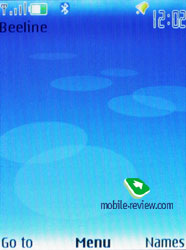
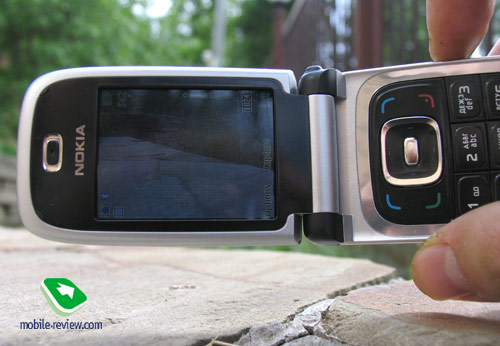

The explanation of such lively colors and lack of mirror substrate
was found on 3rd day of this handset usage, I was trying to wipe
dirt from the display (fat that came from contiguity with ear),
I was trying to use a simple microfiber cloth. I was very surprised
to find two effects: dirt was moving on the screen after cloth movements,
but it was not going off completely, after light contiguity with
display, it had stains over it. Such effect can be seen on most
laptops where matrix is not protected with a special glass, you
can pass over the display with your finger, and you’ll see how stains
will smoothly vanish away. Conclusion drawn from my experiment was
simple: either there is no protective glass on the display, or there
is some new construction used instead.
Video
that demonstrates stains on internal display (wmv, 1.3mb)>>>

Display protection in modern day phones
Before moving on to practical research, I’d like to say some words
about how modern day phones are organized and why protective glass
is used for internal displays of clamshell phones. First of all,
protective glasses were introduced in candy bar phones, they were
a must have, since display is fragile, sensitive to mechanic loads,
including pushes. While being located in one’s pocket, handset could
adjoin with some outside objects, and consequences for display were
usually deplorable. Its protection was introduced in form of protective
glass, and as term glass some plastic cover was used most of the
times, which weren’t basically a glass, but their protectiveness
was present anyway. In practice term “protective glass” settled
down as it is, and any kind of protection used for the display could
have been characterized as one. Due to structural peculiarities,
monochrome displays, and alphabetical-digit displays had bigger
mechanical proof, modern day color displays are a lot thinly organized
(module’s thickness, fixation, most of active elements, this means
that resolution).
One of first problems that became a series issue when plastic was
used as “protective glass” was its dimness during operational process,
appearance of small scratches. Solution was found almost instantly:
expensive models received quartz glass, which was not inexpensive,
but had great stamina against scratches, and they did not affect
picture clearness as well, display was fully readable (as if there
was no glass at all). Quartz glass was not “a must” for monochrome
displays, but were more of image element, they highlighted owner’s
status. Nokia was trendsetter and was first company to ever use
quartz glass in its 8000x series (I wonder if anyone remembers when
this model was released? Welcome to our form if you have the answer).
Introduction of color displays raised issue of qualitative color
rendering, search of new materials, but there was no real alternative
for quartz, all plastic structures had same problem – scratches
vulnerability. As a result, which was totally expected, polishing
materials for mobile phone displays market was formed. For last
few years you can get all sorts of dopes, liquids for display polishing.
They remove small scratches easily, bring back primeval view. Usage
of abrasive materials is dangerous in case screen has special surface
that protects it from the sun or something of the kind, but this
is not very common today. Some skilled people as well as bureau
services offer polishing service, it allows removing deep scratches
from display as well. Both methods are used when you are about to
sell your phone. Common users usually limit operations by removing
dirt from the screen with help of wipes.
Another protection method are special protective films that can
be glued on the display. This idea came from models that were powered
with sensor displays, active exploitation of which lead to active
deterioration. Demand brings supply, and so protective films for
common displays were introduced on the market, this segment is not
that big, but there is a number of users who are using them all
the time. Nokia reacted to such user need and started adding protective
plastic sticker to its smartphones (with silver corner for removing).
Within a month or two such sticker protects the screen, but after
that it tears off by itself. In case of a need, user can buy a 3rd
party film and use it instead.
Display is a very expensive part of any modern day handset, its
repair costs more than repair of most other details which forces
manufacturers to protect their displays with maximal carefulness.
This is why “protective glass” usually has metallic framing in most
models, it gives additional rigidity, prevents display’s collapse
when phone falls down, it also distributes blow’s energy. Glass
itself is fixed to chassis of handset by one of several ways:
- Pasting in case’s frame – widespread method among most manufacturers.
This provides additional cheapness of production, valuable consideration
of fixation quality. As for shortcomings, there is necessity of
case’s part replacement together with the glass, as a rule independent
glass replacement during maintenance is not foresighted
- Glass fixation by screws. This method is more interesting in
terms of maintenance, but does not offer full containment of connection
and is relatively expensive.
- Fixation with help of rubber lining, that has two-side sticky
tape. Glass gets fixated on sort of soft cushion, on the other
hand case becomes the limitation. Low price and high proof, ease
at maintenance made this method well-deserved popular.
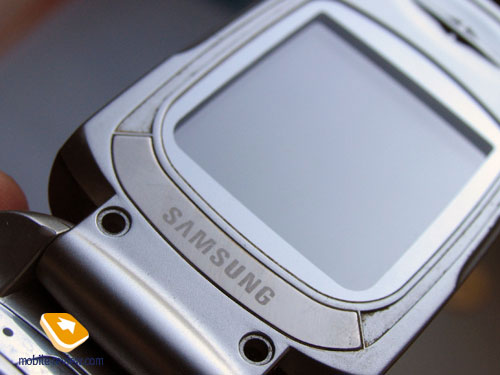

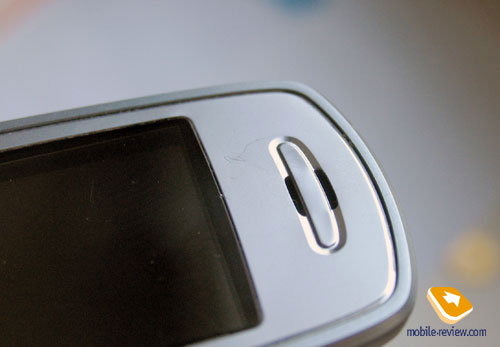

Another aspect that should be highlighted, glass isolation with
rubber linings is possible within first two methods too, and it
all depends on how much effort manufacturer puts into one model.
There are couple of other fixation methods for “protective glass”,
but they are rather exotic and do not play any important role in
our story.
How this is made in Nokia 6131
As you can see, manufacturers are putting great efforts in order
to protect displays in their handsets, they are constantly working
on improving such protection. It was the reason why we were so surprised
to find out that there is no “protective glass” at all for internal
display of Nokia 6131. It’s absence can be found by pressing easily
on the display, you will instantly see stains, and after you remove
your finger from display – they will be gone. Detailed research
of manual, which was in one package with handset did not bring any
special notes about difference of this model when compared with
others (there is only one single note, but we shall discuss it later).
Research of service documents, including list of backup parts shows
presence of frame, fixation of protective glass but lack of glass
itself. Once you rotate handset on-the-mitre, you will see that
protective frame has clearance which is about 1mm big, your nail
will probably fit in that easily.
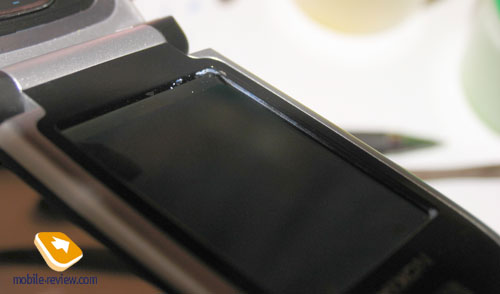
We had several questions about how such construction is justified
and safe, since this is the first phone on the market, there are
no analogues. At the same time we were trying to form explanation
of absence of protective glass, when there is fixation for one.
Here is list of possible explanations, which was brought to life
due to our discussions, feedback of engineers from different companies,
including unofficial comments from Nokia’s developers:
- Increase of contrast and brightness of display, protective
glass makes picture perception worse;
- Auto-opening mechanism balancing, protective glass can negatively
affect the mechanism;
- Preparation for release of “slim” series of models, where a
fight for every millimeter will be initiated, protective glass
will become superfluous, for clamshells in the first place;
- Protective glass was not inserted due to some reasons, perhaps
a failure in processing line or R&D center of Nokia.
Experiments with installing protective glass from different model
on this commercial sample shown that there are no problems with
balancing, spring is doing its job nicely despite additional weight
of 1-2 grams. We installed simple plastic glass, and it indeed affected
picture perception negatively, it was reminding of main model mass
on today’s market for this segment, display was no longer astonishing
in terms of color rendering (middle level, or slightly above). This
is why we can surely say that lack of protective glass was removed
in order to improve display perception. This was a sensible decision,
it is simply unreal to believe that there was a failure inside Nokia’s
headquarters during several development stages for this handset.
Another explanation can be brought up like this: intensive preparation
before launching own “slim” series of handsets. Nokia will be able
to gather statistics with its 6131 to see how much screen failures
there will be (they will not be on warranty), so later it can see
which % is acceptable and how it is different form other models.
What problems can casual consumer face when he will but this handset,
as there is no protection of internal display? List of unpleasant
moments is not that big, but you have to know about it:
- Screen gets soiled easily when compared with
ordinary clamshells, hard surface clean-up (microfiber works badly,
you cannot press the screen, wet wipes for glasses should not
be used either in order to prevent aggressive reaction by contents
of those wipes with display). Special velvet ribbons, that are
manufactured for cellular phones, will simply move dirt from one
corner to another in case with this model;
- Physical display damages. In case you hit
the screen with hard or sharp object, you can damage it easily.
When phone is closed and is located in your pocket, display can
be harmed by covered list of paper, small objects, notes, everything
that can access into space between two sides of phone. During
phone calls display can be damaged by women’s jewelries, usually
women voluntarily or not allow their jewelries to touch the display
(ear-rings and all kinds of piercing). I’d like to make it clear
that there will be no momentum effect from touching display with
ear-ring, but during intensive exploitation this can lead to display
dimness and its failure. Overall screen protection is minimal,
when compared to all other models. Attention. We should draw your
special attention that a scratch of Nokia 6131’s display means
its failure, problems with displaying information, appearance
of dark spot due to depressurization of protective film. A scratch
on typical displays is just a scratch, but here’s it’s different.
You should not be scared of the fact that moisture can affect the
display, sweat drops or small rain will not do any harm. On the
whole water cannot damage the screen, meanwhile it can harm the
phone’s electronics, as it may cause corrosion of contacts. It is
important to note that protective frame of internal display is made
of metal, and its distance from a mirror is about 1mm. Moisture
can access this clearance without any particular efforts. We had
asked chief executive of service center «Service.OK», Gennady
Danilov to comment possible affects of such events. Here’s
what he had to say: «Moisture hit in such case is not so dangerous,
since separate drops cannot harm phone's construction, meanwhile
in case there is a large amount of water it means that this phone
had been drowned in water. In this case most models stamina against
moisture affection is pretty much the same, and there is no big
difference between them. Dirt concentration in clearances, display’s
corners can become a serious issue. It has this property possession
to accumulate. Display’s clearance from dirt is difficult and should
be made with extra cautions. As for women situation can get even
worse since they use cosmetics, it gets easily transferred on the
display and is accumulated on it, dirt becomes colorful».
After one month of this handset’s usage we were able to fully feel
above mentioned aspects. This display is truly easily soiled, and
hard to clean-up. There wasn’t much dust in display’s framing clearances,
but very first cleaning with the help of thin feather has shown
that we were wrong. There had been enough dust in clearances, since
this phone had been carried in pockets.
As for preventive methods of fighting clearances of protective
display, we can offer you some of them. I’d like to point out that
usage of below mentioned procedures will eliminate your warranty
and should be done on your own risk. Once again, please note that
installation of protective film can also be interpreted as modification
of default phone specifications. As a result of this you may lose
your right for backup service. It sounds funny, but this is fact
of today’s support manning. However installing protective film is
most optimal way of fighting phone’s construction.
Choice of protective film does not play a great role, it can be
either specially designed film for this model, or cut-out and fit
for display’s size. It is important that you understand that film
should be installed right after you buy the phone, when screen has
no dust over it, or any finger prints, and so on. Due to clearances
in fixations of protective frame you can install slightly bigger
film, you won’t see its edges. Protective film almost does not affect
image comprehension quality, but it does improve protective specifications
for display. Usually film costs around 2-4 USD. It will cost approximately
same amount of money to install plastic “protective glass” for this
model in case you contact some private specialist. Here’s an idea
for bureau services: add such offer for most hypochondriac clients,
let it cost 5-10 dollars. In my opinion you should be okay with
having protective film, it will be truly enough for handset’s mockery.
But those who realize what they are doing and knows that he often
works in moister conditions, in the rain, should pay more attention
to protecting their handset. In order to do that it will be enough
to place mastic on screen’s edges, but this has to be done extremely
careful. We were using harden plasticine, most important thing is
to fill holes and remove extra pieces, as well as being extremely
careful. From esthetic point of view there are no problems at all,
you will not see plasticine when you look on your display, and from
practical one we have got rid of possibility for moisture to get
inside the handset through those holes. As for disadvantages of
using plasticine, well it is its process of hardening, when you
press display’s frame hard you will see stains on it. You should
look for soft mastic, there is no problem with finding one. In my
opinion such mockery of a handset is unnecessary, but perhaps someone
will find our experience being useful. In this case you will automatically
lose your warranty.
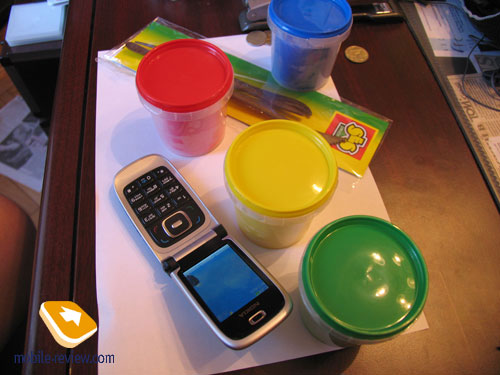
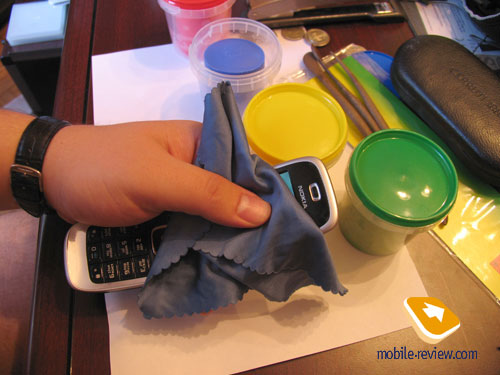
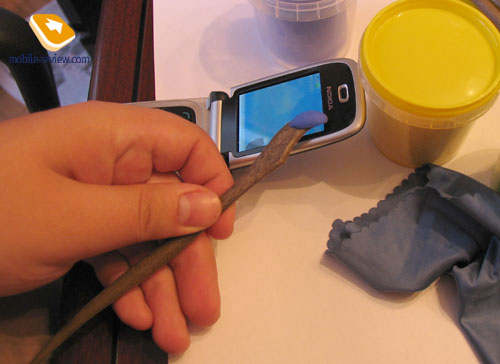
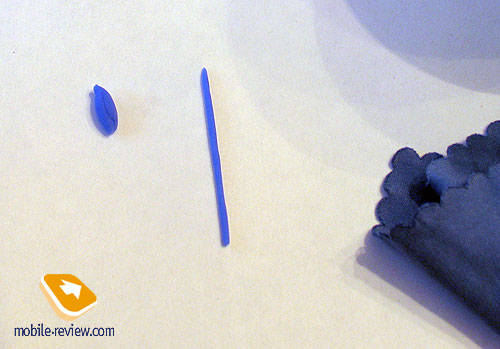
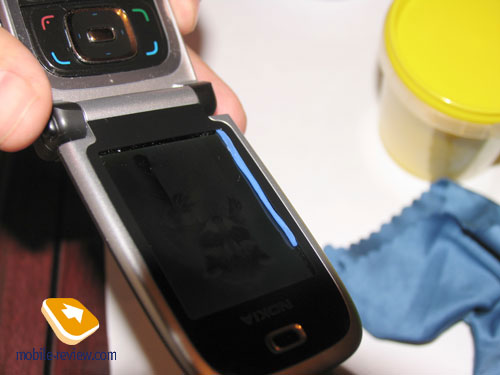
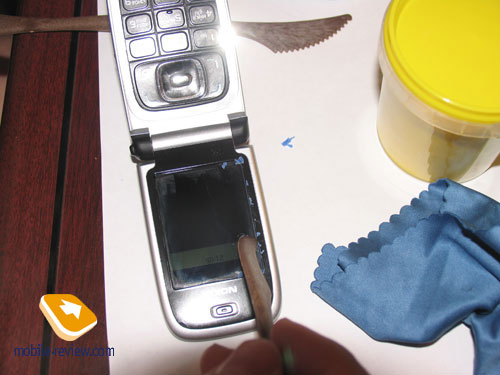
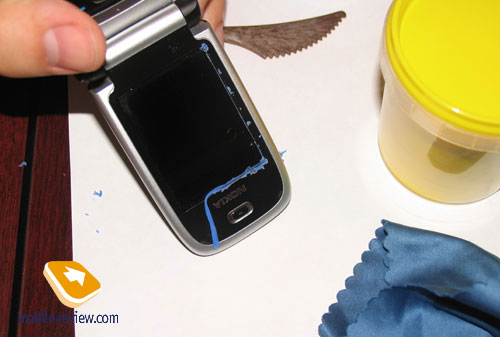
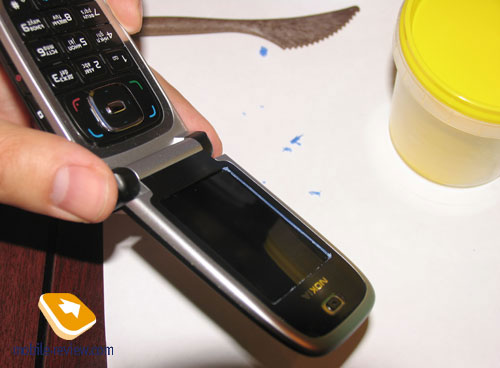
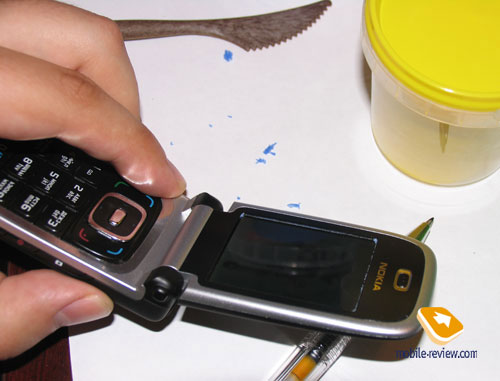

We did not fail to contact Russian representatives of Nokia for
explanation about lack of protective glass in Nokia 6131 model’s
display, we received following answer. This comment was conducted
by Alexey Rogozin, Product Marketing Specialist: «Internal display
in Nokia 6131 has surface durability level of which is enough for
display’s stable work in normal mode, which means following all
standard recommendations for exploitation (not expose to mechanic
damage, temperature drops, direct moisture affection, and so on).
We should note that display installed in this model is not introducing
any superfluous distortions and keeps colors bright and natural.
As for overall recommendation for this model we advice you to take
sensitivity of internal display when compared to displays with protective
glass into consideration. For maximally long high-quality work of
bright Nokia 6131 display it is advisable to avoid touching display
with fingers, avoid mechanic contact with any objects, bar from
any contacts with water (for example: not to talk on the phone during
snow or rain).
In case above mentioned conditions will be followed, which means
reasonably careful usage, functional display specifications will
stay perfect during exploitation term ».
In my opinion this reply by Nokia’s specialists is maximally neutral,
as there is no information about the way screen will act in “combat”
conditions, when it will come into consumer’s hands. In 99 percent
of cases you should not expect physical display failure, this is
highly unlikable scenario (damage done by sharp object or systematic
touch in one and same place with one and same object like ear-ring).
Possibility of display being damaged in Nokia 6131 is higher, than
in ordinary model, it will become even bigger as exploitation term
grows. At same time there is most likely no real problem with lack
of protective glass. Exception will be usage of handset by young
women with massive furnishings, active usage of cosmetics. Twist
of fate is that it will be these women who will become dominant
part of this handset’s auditory.
As for construction’s shortcomings, we can state presence of clearance
and display’s marking, but not its physical specifications by any
chance. It is clear that we have to get statistical data on amount
of display failures due to mechanic damages. But even today it is
possible to propose that they will be no different from numbers
for common phones, or slightly higher. It is impossible to expect
massive problems with display for this model, possibility of such
issue is minimal.
Nokia’s step on rejection of “protective glass” is uncommon and
ambiguous. We cannot expect similar actions done by Nokia in terms
of other models. Nokia 6131 is the only phone with such construction
peculiarity and will remain in this status until end of 2006. There
is no special information about display in User Manual, except for
“Looking after and maintenance” part where you can find something
like this: «Do not touch internal display with hard or sharp objects.
Display can be scratched by ear-rings or any other adornments”.
There is no such line in User Manual packed with any other clamshell
phone. In conclusion that we can draw, we can say that it will not
be monosemantic: women should pay extra attention to usage of this
product. As for men, it does not seem that problems mentioned above
related to them, however we advice them to install protective film
anyway.
In same segment of user manual there is a small line: “For cleaning
of camera lens, range-finding sensor, luminance sensor and so on
– use soft, clean and dry cloth”. I am interested, since when ,
in which model will we have a range-finding sensor, and what for
it will be used?
Display durability test
This review had been modified several times, and my personal attitude
towards presence or lack of protective screen has been changing
and sometimes fundamentally in couple of days. There were numerous
doubts, and Nokia’s move seemed ambiguous, which has called to life
requirement to check display’s durability by artificial methods,
modeling casual situations. We had brand new Nokia 6131 and Nokia
6125 in our test.
What we did. We connected an automatic machine that would imitate
nails by hardness (well, metal would fit more, but we were unable
to get such ferrule for our disposal). Degree of touch was minimal,
this means that there was no hard pushing. Touch of such artificial
finger was not targeted at one spot, but in few, this was area of
lower screen part (2x2 cm) (approximately up to 10 positions of
touches, chosen randomly, contact are was 2x2mm). We had full imitation
of random touch to screen by a finger or a adornment during opening
of handset or beginning of phone call. Ferrule does not have any
sharp edges, this is rounded surface. After launching this test
all what was left is wait for its results and see for how long will
Nokia 6131 display will last.
Loss of display’s containment, breach of film and appearance of
black spot (around 6mm in diameter) occurred after 19247 touches.
At same time in case with Nokia 6125 first haziness of protective
glass occurred only after 24675 touches, contacts. I’d like to point
out that in case with Nokia 6125 screen can be polished and scratches
will disappear.
It seemed that Nokia’s 6125 advantage is clear, but let’s look
and rate our results in terms of user experience. A common human
being uses his mobile phone for 2 years in average, this gives us
730 days of handset usage. Let’s suppose that every time this person
will touch the display with an ear-ring (which is simply unreal
and artificial proposal). This means that he has to touch it 26
times a day so that after two years it would possibly shut down,
or at least part of the screen. In case you make it three years,
then it will be 17.5 times a day.
In my opinion most consumers have less than 17 phone calls a day,
every day that is. It turns out that margin of safety is smaller
when compared to traditional models, but is pretty much blended
with common handset life-cycle. It’s not daily use of a handset
that brings danger, it’s more about accidental affection that can
be caused by a sharp object, with quite an effort to be precise.
Conclusion about internal display of Nokia 6131
Someone may consider that we’re trying to make an elephant out
of a fly, and within these 7 pages we were only talking nonsense.
You can look from another point of view too, no one can deny the
fact that Nokia 6131 is the first phone that has no protective glass.
A unique experience of Nokia 6131 will be interesting for all market,
since up till now we haven’t seen models that lacked protective
glass. In case this experience will be successful then by 2007 there
will be a lot of such phones, and bureau services will have more
work to do. It’s not without purpose that until today none of manufacturers
decided to stop using additional screen protection, including companies
that produce such displays themselves, like Samsung. Nokia’s initiative
is brave, ambiguous, let’s wait for results.
Nokia’s move is targeted to even shorter life cycle for handsets,
for making this parameter closer to capacity for work term. Basically,
such simplification of handsets will lead to steady vanishing of
many models from secondary market, it will become unprofitable to
repair after 3-4 years after they had been released, getting a new
one will become cheaper. Initiative is interesting and is targeted
on primary sales stimulation. Such processes occurred on consumers
electronics market few years ago, manufacturers massively refused
to use metallic chassis in tape decks, switched to plastic which
shortened life cycle of devices.
An end-consumer can note the fact of lack of protective
glass, but this should not become decisive aspect when choosing
the handset, look at other handset specifications, they are more
important.
Review of GSM-handset Nokia 6131. Part 2 >>>
Eldar Murtazin (eldar@mobile-review.com)
Translated by Alexandr "Lexx" Zavoloka (alexander.zavoloka@mobile-review.com)
Published — 21 July 2006
Have something to add?! Write us... eldar@mobile-review.com
|
News:
[ 31-07 16:21 ]Sir Jony Ive: Apple Isn't In It For The Money
[ 31-07 13:34 ]Video: Nokia Designer Interviews
[ 31-07 13:10 ]RIM To Layoff 3,000 More Employees
[ 30-07 20:59 ]Video: iPhone 5 Housing Shown Off
[ 30-07 19:12 ]Android Fortunes Decline In U.S.
[ 25-07 16:18 ]Why Apple Is Suing Samsung?
[ 25-07 15:53 ]A Few Choice Quotes About Apple ... By Samsung
[ 23-07 20:25 ]Russian iOS Hacker Calls It A Day
[ 23-07 17:40 ]Video: It's Still Not Out, But Galaxy Note 10.1 Gets An Ad
[ 19-07 19:10 ]Another Loss For Nokia: $1 Billion Down In Q2
[ 19-07 17:22 ]British Judge Orders Apple To Run Ads Saying Samsung Did Not Copy Them
[ 19-07 16:57 ]iPhone 5 To Feature Nano-SIM Cards
[ 18-07 14:20 ]What The iPad Could Have Looked Like ...
[ 18-07 13:25 ]App Store Hack Is Still Going Strong Despite Apple's Best Efforts
[ 13-07 12:34 ]Infographic: The (Hypothetical) Sale Of RIM
[ 13-07 11:10 ]Video: iPhone Hacker Makes In-App Purchases Free
[ 12-07 19:50 ]iPhone 5 Images Leak Again
[ 12-07 17:51 ]Android Takes 50%+ Of U.S. And Europe
[ 11-07 16:02 ]Apple Involved In 60% Of Patent Suits
[ 11-07 13:14 ]Video: Kindle Fire Gets A Jelly Bean
Subscribe
|


















